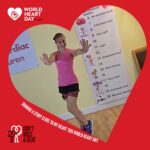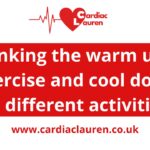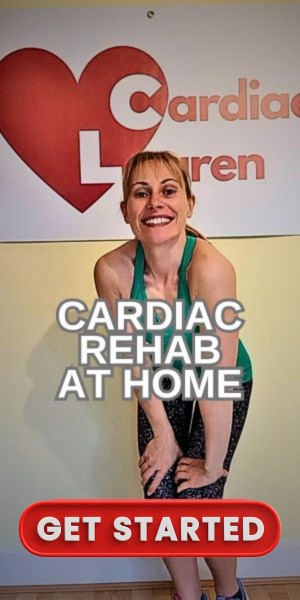Find out why the warm-up is so important when exercising. Understand what we mean by the exercise component and Lauren explains why the cool-down section is vital after an exercise session.
Below is the script for the video so if you are unable to watch it the information is below.
The Warm-Up for Cardiac Patients.
The warm-up must last a minimum of 15 minutes. There are lots of reasons for this, so first of all, it prepares the body for exercise by slowly increasing your heart rate and blood pressure in a nice, safe and graduated way.
We warm up nice and slowly so you’ll see that we only start with the legs to start with. We might do a few little stretches and then we start pulse-raising as we start doing our movements bigger and bigger and start involving the arms, so by the end of the warm-up you are ready to do your exercise session.
Once we start our warm-up, our body is doing all these amazing things and it’s starting to redistribute the blood to your working muscles. This is why we tell you not to exercise too close to having a meal, especially a large meal because what would happen is your stomach has just received all the food, it needs a really good blood supply to digest the food and if you got up and started going and exercising, your muscles will request that blood supply instead. They win out and so that’s why you are likely to get stomach cramps and feel quite ill if you’ve just eaten.
Those of you who go for a walk, have a pub lunch and then continue your walk, please give yourself a nice length of time between finishing your meal and continuing with your walk.
Another reason why we warm up is that it increases the blood flow to the heart muscle and that is really important because obviously, your heart needs a good blood supply. And with that, it dilates all the arteries. Your heart has got all the arteries around it and they start to widen and dilate and therefore the heart actually gets a really good blood supply. If we do a warm-up in a nice gradual manner, then the heart isn’t shocked into exercising.
When we warm up, you are also increasing your breathing rate and we want to do that again in a nice, safe and gradual manner.
You will get warm. That is one of the side effects of exercising. You will warm up, you will start to sweat. So you do have to make sure that you are in a nicely ventilated area. And if you do sweat a lot, you stay hydrated and you may need to have a towel with you.
When you’re warming up and we’re moving the joints around, so think about the shoulder, by moving it around, we’re promoting the release of something called synovial fluid. Think of it as your WD40 for your joints and that is trying to just lubricate the end of your joints. They will then move a little bit smoother. I know a lot of you have got osteoarthritis and you’re thinking that doesn’t happen to me, but that is the process of doing a warm-up.
We’re also really trying to focus the mind on what we’re doing. So our warm-up should mimic what we are going to do in our exercise session. So there’s no point in toe-tapping and lifting your knees and doing all these things if all you’re going to do is for a walk. But you can’t just go for a walk and expect to be warm enough and ready enough to do a circuit class, so do make sure your warm-up mimics what you’re going to do.
And the last thing, as we’ve mentioned in a few other videos, if you do a warm-up, you’re more likely to increase the threshold of getting angina, so then you shouldn’t have any problems exercising.
The Exercise Component
The exercise component of a session should last for at least 20 minutes and 30 minutes is good, but you don’t really need to push it any more than an hour. You can, but you don’t get as many benefits as just sneaking in all your exercise into between 20 and 60 minutes.
Now what we’re trying to do is to get you to raise your heart rate within your training zone. Some of you will have had your heart rate calculated so you know where your heart rate should be. Based on your age, the medicines you’re on, and your fitness level, most of us will be using the RPE scale, that rating of perceived exertion, and we want to be working between RPE 11 and 14, ideally at 13, which is classified as somewhat hard.
Now over time, you are going to get fitter, your muscles are going to adapt to a lot of the exercises, so you need to make sure that when the exercise starts to become a little bit easier, you then need to either increase the intensity, the range of movement, the length of time, or just putting that little bit more oomph into it or carrying a heavier weight.
So you need to just always feel that you’re pushing yourself just that little bit more.
Preferably the exercises need to be cardiovascular, getting your heart and lungs going, you can involve weights as well, but try and make sure that the majority of the exercises you do are cardiovascular.
The Cool-Down
The cool-down part of an exercise session is vital and so many people miss this bit out and you can be very ill and unwell at the end of an exercise session if you don’t cool down. It is just, and if not more, important than the warm-up.
Please note that you should never just stop your exercise and just sit down and leave it like that. That is a big no. You are going to feel unwell, especially if you’re on tablets for you have angina. If you need to sit down, then make sure you move your feet and that just basically keeps your calf muscles pumping and that works as your calf pump.
The calf pump helps get the blood from your feet back up to your heart and your head so you’re less likely to get lightheaded, dizzy, and possibly faint.
Just keep your feet moving.
Your cool-down needs to last a minimum of 10 minutes and it is essential.
What we’re trying to achieve is to gradually bring your heart rate and your blood pressure back down to normal resting levels and that takes a bit of time. You will find after a few minutes you’re no longer huffing and puffing, you don’t feel like your heart is racing and you will feel a lot better.
In terms of your heart rate, our aim is to get it back to within 10 beats of what it was when you first started your exercise, 10 beats off your resting rate.
And then your blood pressure will also start to come down, and that just needs to be gradual.
What was the easiest way to do all this? During the cool-down just walk around. Finish your exercise, walk around your room or the garden, if you’re playing badminton or tennis, walk around the court if you’re in the gym get yourself back onto the treadmill or just walk around the gym and you’ll be surprised how quickly you will start to recover.
Now, one of the other reasons why a cool-down is important is that we need to remove the circulating catecholamines from the bloodstream.
Now catecholamines are waste products from exercise and one that you have heard about is adrenaline. Adrenaline is wonderful for during exercise as it makes your heart pump harder, and faster and it’s perfect to get us going while we’re exercising, but we really don’t need that in the bloodstream whilst we are cooling down and so our body will start reabsorbing it, just getting ourselves back to our normal pace, our normal heart rhythm, just nice and slowly after exercising.
So it’s really important you reduce those circulating catecholamines because they can actually increase the risk of you getting an arrhythmia which is an irregular heartbeat.
There is, at the end of the cooldown or the end of the exercise session, a risk that you feel lightheaded, dizzy or actually faint if the blood pools in your legs and you’re going to become hypotensive, low blood pressure, again keep your feet moving virtually to the end of the cooldown, for the full 10 minutes.
We really encourage people to stretch at the end of an exercise session, and that is important because the muscles are warm and they really like being stretched when they’re warm.
Every time you’ve done an exercise, your muscles have been shortening to give you that force that you need, and if you never stretch and lengthen them back to the state they’re supposed to be, they’re going to just become dull, heavy, achy, and you’re more inclined to get cramp. And then you’re more inclined to get aches and pains and possibly injuries because your muscles haven’t been stretched back to the right length.
You will, at the end of your 10 minutes, probably still feel warm, hot, and sweaty, but you should feel that you have fully recovered from the exercise session.
I hope that helps explain the importance of a warm-up and cool-down in Phase 4 Cardiac Rehabilitation exercise classes. Lauren uses the same format of warm-up in her face-to-face classes.
Come and enjoy the classes with Cardiac Lauren!
Follow me on Facebook.






